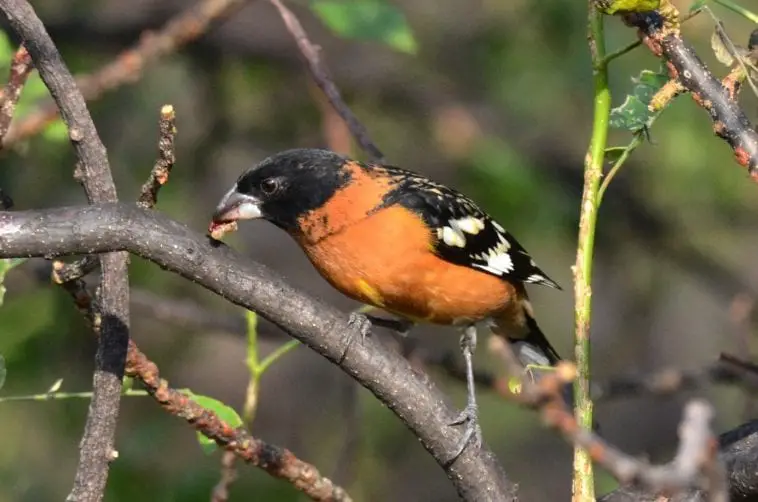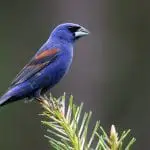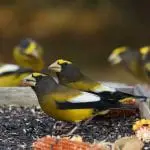Scientific Facts
| Common Name | Black-headed grosbeak |
| Scientific Name | Pheucticus melanocephalus |
| Lifespan | 11+ Years |
| Size | 7.5 inches |
| Mass | Up to 1.7 oz |
| Habitat | forests |
| Range | Western North America |
Information & Physical Appearance

Weighing between 1.2 – 1.7 oz., mature black-headed grosbeaks are known to reach up to 7.5 inches in length. These hefty, medium-sized songbirds are visibly slimmer and more compact in size and shape as compared with the American robin (Turdus migratorius) and are bulkier, as well as larger than the House Finch (Haemorhous mexicanus).
Scientifically referred to as Pheucticus melanocephalus, the black-headed grosbeak is part of the order Passeriformes, the family Cardinalidae.
The black-headed grosbeak is characterized by a very large, grayish, conical-shaped bill. The bill is especially thick at the base. Meanwhile, the head of this bird species is large, and the neck is short and thick.
The somewhat chunky, compact looks of the black-headed grosbeak is further accentuated by the short tail.
These birds’ wingspan is estimated at 12.6 inches. When in flight, these birds will flash wonderful yellow under the wings, which further enhances their natural beauty.
Breeding male black-headed grosbeaks can be distinguished from adult females by their blackheads, and the rich orange-cinnamon coloration. Adult males’ wings are black and white. The back is black and orange.
Adult female black-headed grosbeaks do also display beautiful orangish tones on their underparts, with the body coloration on the upper parts being brown and streaky. The neck, as well as the eyebrow, are buffy.
Immature black-headed grosbeaks resemble the physical appearance of adult females.
Lifespan
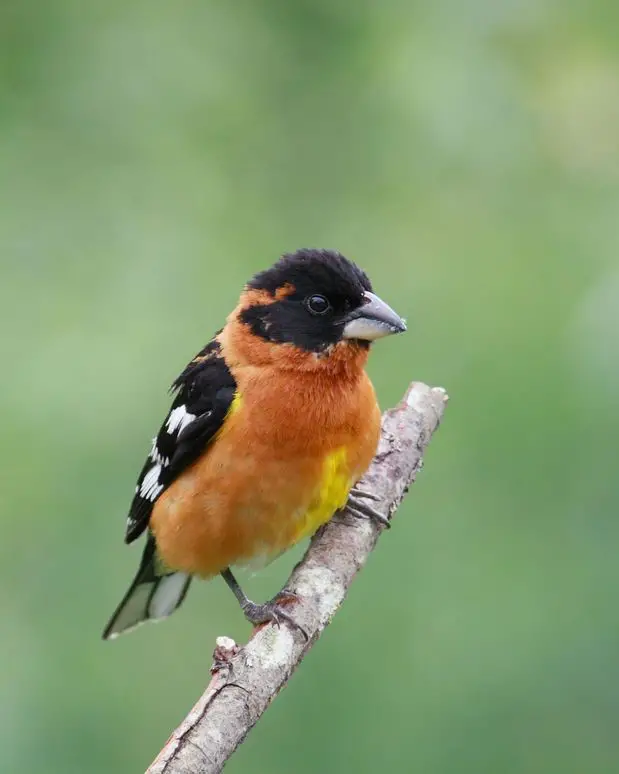
The oldest recorded black-headed grosbeak was an individual recaptured and then successfully rereleased during the course of banding operations taking place in Montana. The oldest known individual was at least 11 years and 11 months of age.
In captivity, black-headed grosbeaks can live up to 25 years.
Ecosystem & Habitat
Black-headed grosbeaks’ range spans across the southwestern parts of Canada to Mexico’s mountains, and from the middle of the Great Plains in the US to the Pacific Coast.
The black-headed grosbeaks found in Canada and the US are highly migratory. They are to winter in Mexico.
Interestingly, because of the populations of rose-breasted grosbeaks and black-headed grosbeaks overlapping in the Great Plains, the birds have been assessed to have interbred to some extent.
Shortly after the end of their breeding season, black-headed grosbeaks often tend to be on the search for areas rich in berries. Early in the fall, the birds are to migrate south. Late in the spring, they are to return north, doing so in flocks.
The black-headed grosbeaks’ habitat consists of mixed woodlands, as well as the very edges of mountain forests. Also, these birds are known to inhabit desert streams. Nonetheless, Pheucticus melanocephalus species are beloved visitors to gardens and backyards.
The optimal, most favored, ideal habitat of these birds consists of a diverse understory, located under some large trees.
When it comes to the breeding habitat, complex habitats that feature a wide variety of plants, and most importantly, ready access to water, are sought out. Examples of an ideal breeding habitat include aspen on floodplains, broken pine forests, orchards, gardens, stream margins, groves of cottonwood, suburban developments, and deciduous valleys and canyons alike.
Black-headed grosbeaks will avoid dense coniferous forests, unbroken and/or dry grassland, chaparral, and desert in the mountainous stretches. Instead, they are to inhabit edges where the types of habitats listed above do either meet others or are disturbed.
The winter habitats chosen by grosbeaks include Mexico’s tropical and subtropical lowlands, sharing similar features.
When migrating, black-headed grosbeaks are disposed to seeking out berries-rich trees and shrubs.
Food & Diet

The black-headed grosbeak’s diet is quite varied, as this bird species will gladly take various seeds, and especially pine seeds, among others, as well as insects, spiders, berries, and different fruit.
It is during the summer season when black-headed grosbeaks are to mainly feed on snails, insects, and spiders. Grosbeaks are known to consume a big amount of seeds and monarchs in their wintering grounds.
Also, during the winter season, grosbeaks will come to bird feeders filled with seeds, and especially those filled with sunflower seeds, and/or delicious fruit. Feeders where the grape jelly is available are also favored by grosbeaks, as they are to join northern orioles when it comes to feasting on this sweet treat.
Thanks to their massive bills, black-headed Grosbeaks are masters at cracking seeds. Not the least, their massive bills are powerful “weapons” that serve the purpose of snatching and crushing snails and insects described as “hard-bodied.”
The grosbeaks’ breeding season diet consists of approximately 60% live food, including various small animals, such as spiders, and especially beetles. Meanwhile, seeds and fruits make up for about 40% of their breeding-season food.
It is during migration when berries are especially favored. The birds are to seek out berries among various wild fruit, with some of their most common meals being elderberries, poison oak, and juneberries.
Other foods consumed by the grosbeaks on a regular basis include different weed seeds, such as chickweed, dock, bur clover, and pigweed, as well as different grains, such as wheat and oats.
Black-headed grosbeaks will also feed on various cultivated fruit found in orchards, like plums, crabapples, figs, cherries, blackberries, and apricots.
During the springtime and the summertime, these birds can be commonly spotted feeding on nectar feeders intended to attract orioles, as well as at feeders filled with sunflower seeds.
Behavior
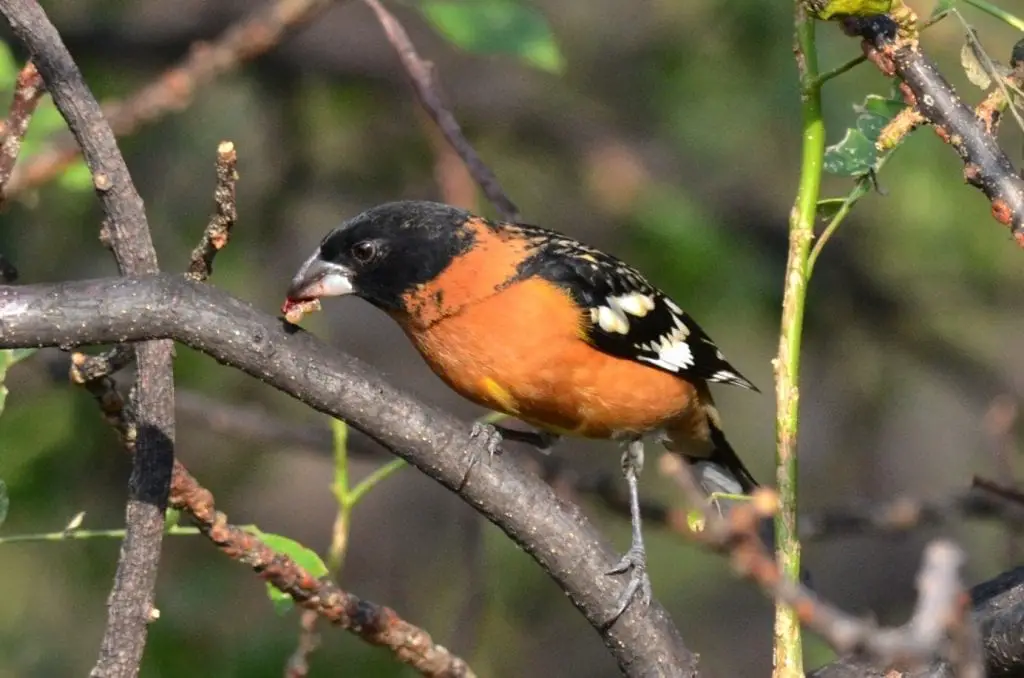
Black-headed grosbeaks will often remain hidden away from sight while hopping in dense foliage and searching for seeds and insects.
In the spring and in the summer, male grosbeaks will sing from prominent perches in the treetops. Their song is described as a rich, whistled lilt.Also, because of the squeaky, short chip note present, these birds can be easily found by simply listening for their pleasant song.
Even though both sexes sing, there is a difference in the song of the female black-headed grosbeak, as compared with the song of the male black-headed grosbeak.
Curiously enough, both sexes are known to sing while engaged in the process of incubating the eggs in their nest. Also, both parents almost equally share chick-rearing duties, including feeding the young and sitting on the eggs.
The courtship behavior of males includes display courtship flights, with the tails and wings being spread. More specifically, these flights are called “nuptial flights.”
Nuptial flights last between 8 – 10 seconds. During this period of time, the sexually mature male is to flutter up from a perch, spreading his wings and tail in order to reveal the bold, impressive patterns in black and white, while simultaneously singing. The male is to rise several feet from the perch before finally settling back on the very same perch.
Both sexes will attack other grosbeaks if the latter is to intrude on the breeding pair. Interestingly, singing is also helpful when it comes to territorial defense.
If aerial grappling attacks are to occur, these can often be ferocious. Some of the species that black-headed grosbeaks typically tolerate to come near the nest include bushtits and warblers. However, predators, such as Steller’s Jays, as well as Western Scrub-Jays, will be violently attacked.
During fall migration and during the winter season, it is possible for Black-headed Grosbeaks to form loose flocks.
These birds are known to forage on the ground or directly in the foliage. They do forage in low vegetation, too. Black-headed grosbeaks are prominent berry eaters, too.
When the young chicks are fed, they do also sing to their mother while displaying their yellow under-feathers by rustling their wings.
Black-headed grosbeaks do lung at prey, although they do so less frequently than gleaning a large proportion of their daily food in the understory and in the treetops. Only occasionally, these birds will also snatch flying prey.
Hopping on the branches of trees or at bird feeders, black-headed grosbeaks can be commonly spotted engaged in cracking hard-bodied insects and seeds using their heavy, conical bills.
Shortly after spring migration, pairs that are described as “tight-knit” are to quickly form.
Reproduction
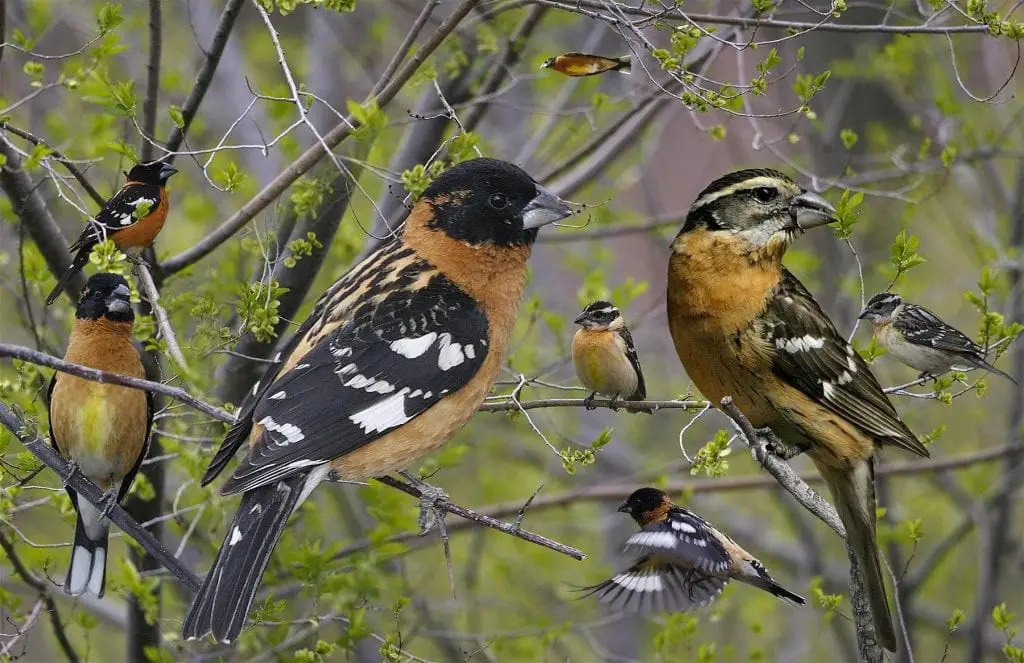
Young black-headed grosbeaks are fed by both of their parents.
As of now, the monogamy of this bird species remains unclear and is currently being an understudy. However, there is little doubt that pair bonds do last for at least one breeding season. More specifically, the pair bonds are suggested to last for only a single breeding season, based on the existing evidence up-to-date.
Usually, one brood is produced per breeding season. However, it is possible for grosbeaks to produce two broods per breeding season, as this has been already documented in the foothills of California’s Sacramento Valley, where a pair of grosbeaks was reported to have raised two broods instead of a single one.
Typically, black-headed grosbeaks build their nests in the outer branches of a small bush or a small deciduous tree. Most importantly, nests are built on trees or bushes that are located near a stream. Nests are positioned at the height of about 25 feet up in the tree/bush.
In general, these birds’ nests are well-concealed, naturally camouflaged by branches and leaves. Additionally, in order to ease nest cooling, spots may be chosen.
It is the female black-headed grosbeak’s duty to build the nest. The nest is loosely constructed and is somewhat bulky. It measures about 2-4 inches deep and about 5-7 inches across.
Stems, rootlets, slim, fine twigs, and pine needles are used for constructing the nest. There is no cementing or mud utilized. The nest is then lined with hair, string, finer stems, rootlets, and green material, forming a wide inner cup, about 3-4 inches in size, with a deep hollow measuring 1-2 inches.
Usually, the nest is finished in about 3 – 4 days. During the first days of constructing the nest, most of the building material is to be gathered by the female. Afterwards, she is to intensify the assembly of the nest.
It is suggested that the loose construction of the nest helps to provide proper ventilation to help the eggs cool. The nest is so loosely constructed that sometimes, it is possible to see the eggs through the nest’s bottom.
The black-headed grosbeak’s clutch consists of 2 and up to 5 eggs. Each egg is 0.9 and up to 1.1 inches in length vs. 0.7 and up to 0.8 inches in width and is pale blue to greenish blue in color. Also, the eggs feature reddish-brown or brown spotting.
The incubation period lasts for 12- 14 days. Meanwhile, the nestling period lasts for 10 – 14 days.
Upon hatching, the young chicks are helpless. They are almost entirely naked. Their eyes are closed. The apricot skin of the baby chicks is covered with a sparse grayish-white down.
Health Risks/Survival Threats/Conservation
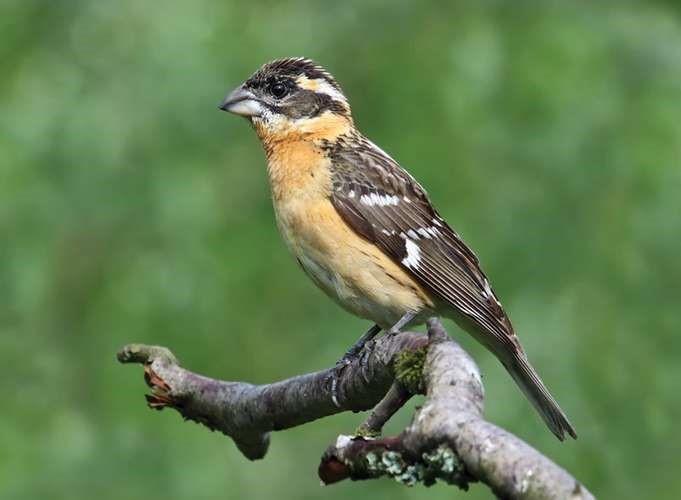
According to the North American Breeding Bird Survey that was conducted between 1966 – 2014, the populations of Black-headed Grosbeak are either stable or increasing throughout their natural range.
Furthermore, according to data shared by Partners in Flight, the global breeding population of black-headed grosbeaks is estimated at 14 million.
75% of the breeding populations are to spend some part of the year in the U.S. 100% of the breeding populations are to be found in Mexico, while only 4% are to breed in Canada.
On the Continental Concern Score, Pheucticus melanocephalus are rated a 9 out of 20. Black-headed grosbeaks are not listed on the 2014 State of the Birds Watch List.
These birds are protected under the United States Migratory Bird Treaty Act.
Even though modern-day urbanization has destroyed some of the black-headed grosbeaks’ prime habitats, these hardy feathery fellows have proven as species with especially high adaptability to change.
These birds are not particularly pretentious neither when it comes to nest materials, nor when it comes to breeding habitat. Instead, they do nest in many different species of shrubs and trees alike.
Moreover, these birds are not fussy eaters. They thrive on mixing an array of plant and animal foods.
While black-headed grosbeaks do keep a distance from human activity, and especially in the case of intensive human activity, these amazing living creatures are known to inhabit various disturbed landscapes, such as suburban garden belts, irrigated field edges, orchards, and nonetheless, second-growth forests.
Scrub jays and Steller’s jays are very significant nest predators in some areas, though. However, black-headed grosbeaks are reported to be relatively resistant to other instances of brood parasitism, in particular, in cases of Brown-headed cowbirds troubling other birds within their range.
Other known predators include rock squirrels, magpies, deer mice, chipmunks, weasels, domestic cats, garter snakes, striped skunks.
Availability – Where to Get a Black headed Grosbeak

Black-headed grosbeaks are not kept as pets. The easiest way to get a closer glimpse of these beautiful creatures by attracting them using sunflower bird feeders.
Also, black-headed grosbeaks are often admired in the wild by keen bird watchers.From early spring and through the summer season, they can be spotted in the treetops, gleaning in dense foliage in almost any of these birds’ diverse habitat. Their lilting, rich song is a great clue for easy identification, and so is their swift spik call.
Interesting Facts
1. The male Black-headed Grosbeak is to acquire his colorful breeding plumage not any sooner before the male turns 2 years of age. It is only one yearling males that are capable of defending a territory, as well as capable of attempting breeding. Yearling males closely resemble adult males; however, some may still resemble a female at this point in development.
2. In central Mexico, it is both black-headed grosbeaks and monarch butterflies to spend the wintertime. In this range, the black-headed grosbeak is one of the few natural predators of monarch butterflies. Because of the toxins found in the monarch, these butterflies are poisonous to most of the bird species. It is only the black-headed grosbeak, among a few other species that are capable of eating monarch butterflies without getting poisoned.
Intriguingly, black-headed grosbeaks are to only feed on monarch butterflies following 8-day cycles on an average. Apparently, it is by following these cycles how grosbeaks have enough time to eliminate the toxins released by the monarch.
3. Even though male black-headed grosbeaks are known for their showy plumage, they are very dedicated parents, sharing equal parental care for their young in both incubating the eggs and feeding the chicks, about equally with females.
4. The first part of the Black-headed Grosbeak’s scientific name – “Pheucticus” – refers to either the Greek word “pheuticus” which translates into “shy,” or to the word “phycticus” which means “painted with cosmetics,” making an excellent fit for a showy bird engaged in foraging in dense foliage.
The second part of the black-headed grosbeak’s scientific name – “melanocephalus” – means “black-headed.”
5. Both sexes have a solid reputation as loud singers. The rich song of the males is generally performed by the females, too, although in a detectably simplified version. Sometimes, the female is to sing a full male song. This interesting behavior is believed to be used for the purpose of deceiving the male in the pair that there are competitors nearby, thus, making the male spend more time at the nest in return.
How to Care for the Black headed Grosbeak
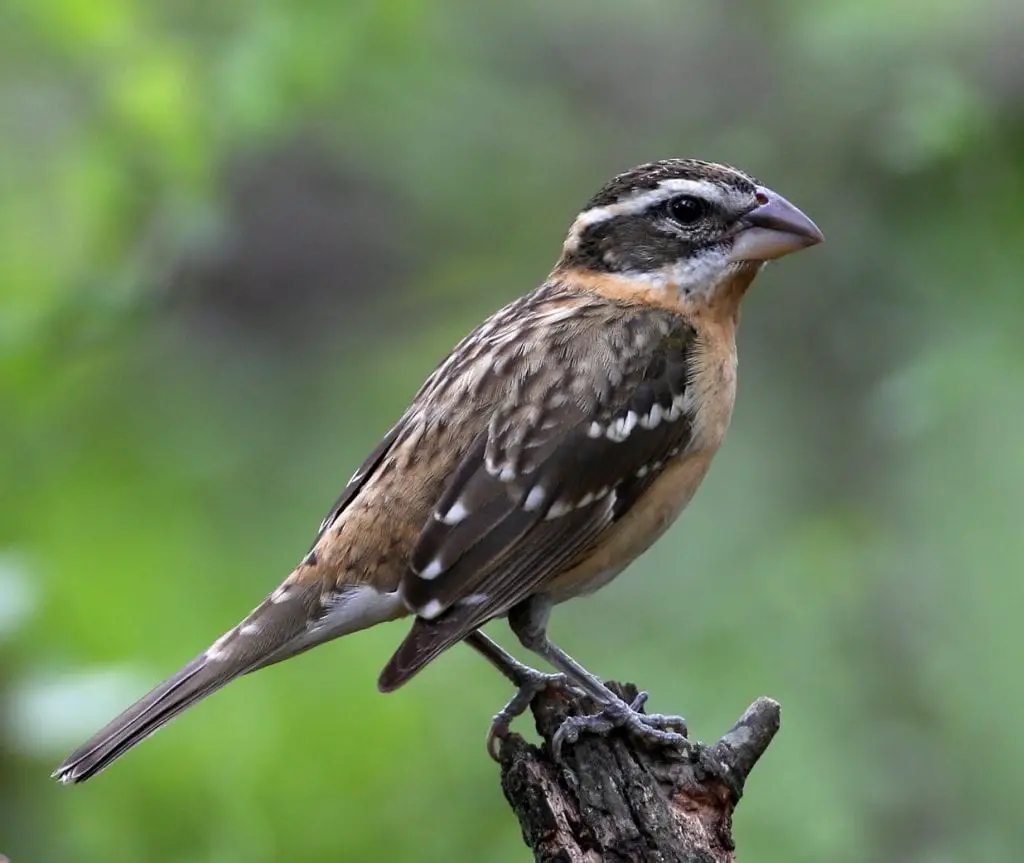
To take good care of the black-headed grosbeak, bird care enthusiasts can attract these feathery fellows by setting sunflower seed feeders. It is a must to keep high hygiene at the bird feeding sites to ensure the birds’ welfare.
Nectar feeder stations set out for attracting orioles will frequently attract black-headed grosbeaks, too.
If enough cover and water are available nearby, black-headed grosbeaks may also choose to nest in gardens and backyards.
FAQs
Where Do Black headed Grosbeaks Live?
Black-headed grosbeaks live in a variety of habitats, but the most favored ones include mixed wooded areas, as well as deciduous wooded areas. Black-headed grosbeaks enjoy living in areas dominated by thick bushes and large trees, e.g., shrubs with conifer forests and broadleaved trees’ patches, river bottoms, wetlands, lakeshores, streamside corridors, as well as suburban areas.
Where Do Black headed Grosbeaks Nest?
Black-headed grosbeaks nest in wooded areas near freshwater, such as streams and lakes. The nests are usually placed up to 25 feet height in the outer branches of a selected small-sized shrub or a small deciduous tree.
Do Black headed Grosbeaks Migrate?
The black-headed grosbeaks in the western part of these birds’ range are known to winter in Central America and Mexico, while many of the grosbeaks inhabiting the eastern parts of their range are known to winter in northern South America and Panama. Some grosbeaks are to migrate overland around the Gulf of Mexico, yet most of them will choose to migrate by flying across the Gulf instead.
Are Grosbeaks Finches?
It is cardueline finches that belong to the family Fringillidae. Black-headed grosbeaks are cardinals that belong to the family Cardinalidae. Only the finches in the family Fringillidae are considered true finches.
What Does a Black headed Grosbeak Look like?
The breeding male black-headed grosbeak is distinguished by the vibrant, rich orange-cinnamon coloration contrasting the black-and-white wings and the black head. Female black-headed grosbeaks and immature black-headed grosbeaks display brown coloration on the upperparts, with warm orange on the breast zone.
How to Attract Grosbeaks to my Yard/Garden?
The best way to attract black-headed grosbeaks to gardens or yards is to place a hopper-type seed feeder and fill it with black oil sunflower seeds. Good perching space should be provided, too.
Do Grosbeaks Like Grape Jelly?
Yes, black-headed grosbeaks to like grape jelly, and that’s why they are commonly attracted to nectar type of feeding stations set out for orioles. Because of the high sugar content in grape jelly, it is a high-energy food; however, it must be only offered in moderation, e.g., only a single spoonful of grape jelly in a jar lid or shallow dish.

